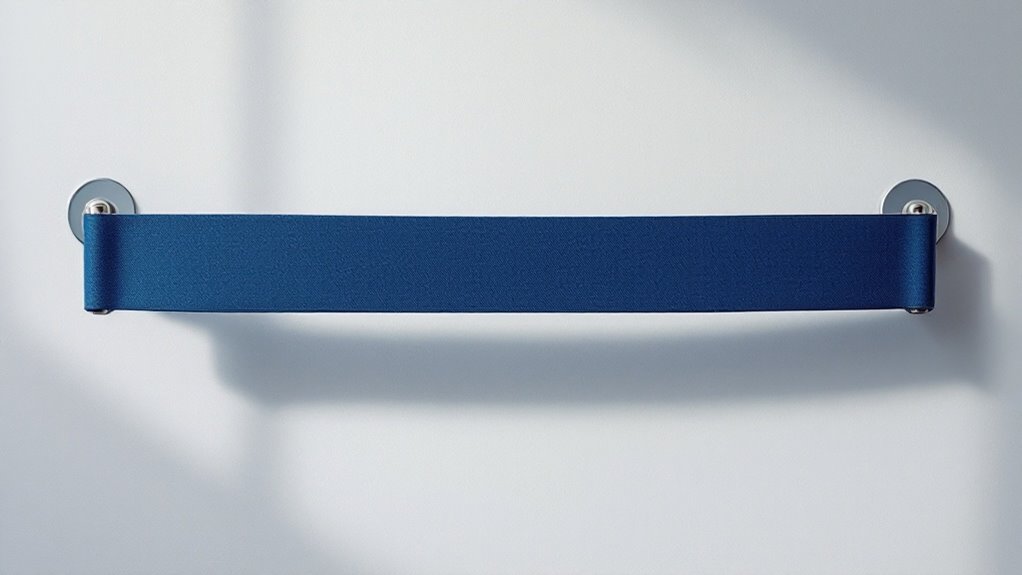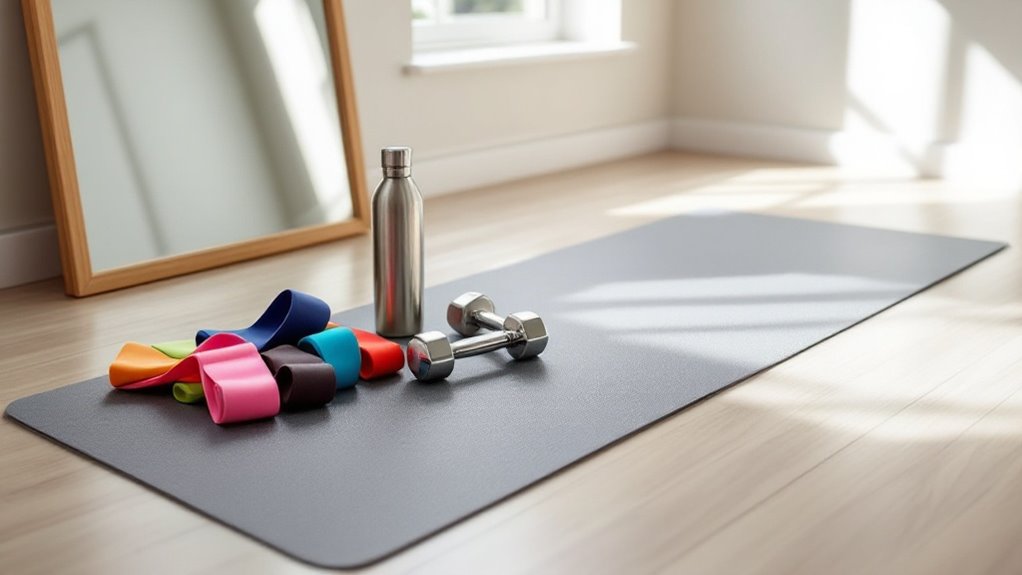Exercises for External Shoulder Rotation

External shoulder rotation exercises strengthen essential stabilizing muscles that protect the shoulder joint and improve range of motion. Key movements include standing band rotations, sidelying dumbbell work, and 90-90 rotations performed with proper form and controlled tempo. Starting with lighter weights helps master technique before progression. Regular practice improves daily activities, athletic performance, and injury prevention. Discovering the right combination of exercises releases superior shoulder health and function.
Key Takeaways
- Standing Band Rotation exercises strengthen external rotators by anchoring a resistance band and rotating the arm outward at hip level.
- Side-lying External Rotation with a light dumbbell targets rotator cuff muscles while maintaining proper shoulder blade position.
- The 90-90 External Rotation exercise develops shoulder stability by rotating the forearm upward with the upper arm parallel to ground.
- Cable Face Pulls combine external rotation with back strengthening, improving both shoulder function and posture.
- Maintain tucked elbows and controlled movements during all exercises, starting with light resistance to master proper form.
Understanding External Shoulder Rotation and Its Importance

External shoulder rotation stands as one of the most critical yet often overlooked movements in shoulder biomechanics. This fundamental motion involves rotating the upper arm away from the body while maintaining proper shoulder blade positioning, essential for daily activities and athletic performance.
Like a door hinge that needs proper maintenance, the shoulder's external rotation capability directly impacts its overall function and injury prevention. When neglected, it can lead to decreased range of motion, rotator cuff problems, and impingement issues.
Strong external rotators help stabilize the shoulder joint, improve posture, and boost performance in activities ranging from throwing a baseball to reaching overhead during workouts.
For optimal shoulder development, combine external rotation exercises with compound exercises like squats and deadlifts to build overall strength and muscle mass.
Essential Equipment and Preparation

Before starting any shoulder rotation exercises, proper setup and equipment selection lay the foundation for effective training.
Essential items include resistance bands of varying tensions, a sturdy anchor point, and a flat exercise surface. A lightweight dumbbell (2-5 pounds) can also be beneficial for beginners.
Wearing comfortable, non-restrictive clothing allows for proper movement tracking. A mirror helps maintain correct form throughout exercises. Temperature-controlled environments prevent muscle stiffness. Having a water bottle nearby supports proper hydration during training.
For safety and effectiveness, remove any jewelry or accessories that could interfere with movement patterns or catch on equipment.
Maintaining balanced nutrition habits helps support muscle recovery and joint health during exercise programs.
Step-by-Step Exercise Guide

The following shoulder rotation exercises form a thorough progression from basic to advanced movements.
Building strong, mobile shoulders requires a methodical approach, starting with foundational movements and advancing to complex exercises.
Each exercise builds upon the last, gradually increasing mobility and strength in the rotator cuff muscles.
- Standing Band Rotation: Stand sideways, holding resistance band at hip level, rotate arm outward while keeping elbow at side
- Sidelying External Rotation: Lie on side, holding light dumbbell, rotate arm upward while keeping elbow tucked
- 90-90 External Rotation: Seated, arm at shoulder height, rotate forearm up toward ceiling
- Cable Face Pull: Stand facing cable machine, pull handles toward face while externally rotating shoulders
Complementing these movements with prone extension raises can further enhance posterior shoulder strength and mobility.
Tips for Proper Form and Common Mistakes

Proper form during shoulder rotation exercises serves as the foundation for both safety and effectiveness.
Common mistakes include moving too quickly, using excessive weight, and allowing the elbow to drift away from the body.
To maintain proper form, keep the upper arm pressed against the torso, maintaining a 90-degree bend at the elbow. Control the movement throughout the entire range of motion, avoiding momentum or swinging motions. The shoulder blade should remain stable and retracted.
Watch for signs of compensation like arching the back or lifting the shoulder.
Start with lighter weights to master the form before progressing. If pain occurs, reduce the weight or consult a professional.
Consider switching to neutral grip dumbbells if the traditional barbell position causes discomfort in your shoulders.
Frequently Asked Questions
How Long Should I Wait Between Sets of External Shoulder Rotation Exercises?
Rest intervals between sets should range from 30-90 seconds, depending on training goals and intensity level.
For strength building, take longer 60-90 second breaks to allow full ATP replenishment.
For endurance, stick to shorter 30-45 second rest periods.
Listen to your body – when breathing normalizes and muscles feel ready, that's the signal to begin the next set.
Can I Perform These Exercises While Recovering From a Rotator Cuff Injury?
A physical therapist recently worked with an athlete who attempted to rush back into training after a rotator cuff tear, resulting in a significant setback.
Performing shoulder exercises during injury recovery requires strict medical guidance. Only attempt these movements after receiving clearance from a healthcare provider.
They will assess healing progress and provide specific modifications, timing, and intensity levels appropriate for the individual's recovery stage.
Should I Feel a Burning Sensation During External Shoulder Rotation Exercises?
A burning sensation during external rotation exercises should not be intense or painful.
Mild muscle fatigue is normal, but sharp pain, intense burning, or discomfort indicates improper form or potential injury.
Stop immediately if experiencing these symptoms and consult a healthcare provider.
The goal is to feel controlled muscle activation and mild tension, not burning pain that could signal tissue damage.
How Many Times per Week Should I Do External Shoulder Rotation Exercises?
External shoulder rotation exercises should be performed 2-3 times per week, allowing 48 hours between sessions for muscle recovery.
For beginners, start with 2 sessions weekly and gradually progress to 3 as strength improves. This frequency optimizes muscle adaptation while preventing overtraining.
Each session should include 3 sets of 12-15 repetitions, maintaining proper form throughout the movement.
At What Age Should Someone Start Incorporating External Shoulder Rotation Exercises?
While some might think shoulder exercises are only for adults, external rotation work can safely begin during the early teenage years (12-14) when organized sports typically start.
This helps establish proper movement patterns and joint stability early on. However, the focus should be on proper form using bodyweight or light resistance bands before progressing to weights.
Adults can start at any age with appropriate medical clearance.
Final Thoughts
External shoulder rotation exercises can revolutionize shoulder health when performed consistently and correctly. While these movements may seem simple, they pack the strength of a thousand arm wrestlers into their subtle motions. By following proper form, using appropriate resistance, and maintaining dedication to the routine, anyone can develop stronger rotator cuffs, improve mobility, and greatly reduce their risk of shoulder injuries.


